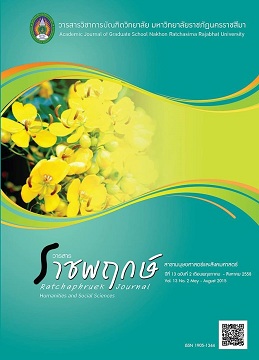ผลการใช้บทเรียนคอมพิวเตอร์มัลติมีเดีย วิชาประวัติศาสตร์ เรื่อง ยุคสมัยก่อนประวัติศาสตร์ในประเทศไทย ชั้นมัธยมศึกษาปีที่ 1
Main Article Content
Abstract
การวิจัยครั้งนี้เป็นการศึกษาผลการใช้บทเรียนคอมพิวเตอร์มัลติมีเดีย วิชาประวัติศาสตร์ เรื่อง ยุคสมัยก่อนประวัติศาสตร์ในประเทศไทย ของนักเรียนชั้นมัธยมศึกษาปีที่ 1 โดยมีวัตถุประสงค์เพื่อ 1) พัฒนาบทเรียนคอมพิวเตอร์มัลติมีเดีย วิชาประวัติศาสตร์ เรื่องยุคสมัยก่อนทางประวัติศาสตร์ในประเทศไทย สำหรับนักเรียนชั้นมัธยมศึกษาปีที่ 1 ให้มีประสิทธิภาพตามเกณฑ์ 2) เพื่อเปรียบเทียบผลสัมฤทธิ์ทางการเรียน ของนักเรียนชั้นมัธยมศึกษาปีที่ 1 ระหว่างกลุ่มที่เรียนด้วยบทเรียนคอมพิวเตอร์มัลติมีเดีย กับกลุ่มที่เรียนด้วยวิธีปกติ และ 3) เพื่อศึกษาความพึงพอใจ ของนักเรียนชั้นมัธยมศึกษาปีที่ 1 ที่เรียนด้วยบทเรียนคอมพิวเตอร์มัลติมีเดีย กลุ่มตัวอย่างเป็นนักเรียนชั้นมัธยมศึกษาปีที่ 1 โรงเรียนวังน้ำเขียวพิทยาคม โดยเป็นกลุ่มทดลอง จำนวน 30 คน และกลุ่มควบคุม จำนวน 30 คน เครื่องมือที่ใช้ในการวิจัย ได้แก่ บทเรียนคอมพิวเตอร์มัลติมีเดีย แผนการจัดการเรียนรู้ แบบทดสอบวัดผลสัมฤทธิ์ทางการเรียน และแบบสอบถามความพึงพอใจ วิเคราะห์ข้อมูล โดยการหาค่าเฉลี่ย () ค่าร้อยละ (percentage) ค่าส่วนเบี่ยงเบนมาตรฐาน (S.D.) และทดสอบค่าที (t-test)
ผลการวิจัยพบว่า บทเรียนคอมพิวเตอร์มัลติมีเดียมีประสิทธิภาพ E1/E2 เท่ากับ 85.62/82.50 สูงกว่าเกณฑ์ที่ตั้งไว้ กลุ่มที่เรียนด้วยบทเรียนคอมพิวเตอร์มัลติมีเดีย มีผลสัมฤทธิ์ทางการเรียนสูงกว่ากลุ่มที่เรียนด้วยวิธีปกติ อย่างมีนัยสำคัญทางสถิติที่ระดับ .05 และกลุ่มที่เรียนด้วยบทเรียนคอมพิวเตอร์มัลติมีเดียมีความพึงพอใจต่อบทเรียนคอมพิวเตอร์มัลติมีเดียอยู่ในระดับมากที่สุด
Results of Using Computer Multimedia Entitled Pre-history Era in Thailand for Matthayomsuksa 1 Students
This reseach aimed to study the results of using computer multimedia entitled pre-historical era in Thailand for Matthayomsuksa 1 students. The proposes were 1) to develop computer multimedia entitled pre-historical era in Thailand for Matthayomsuksa 1 students with the efficiency at 80/80 2) to compare the learning achievement of Matthayomsuksa 1 students between group using computer multimedia and group using traditional method and 3) to study the satisfaction of Matthayomsuksa 1 students using computer multimedia.
The samples were the students of Wangnamkgiew Pithayakom School ; 30 students for the experimental group and 30 students for the control group. The research instruments were computer multimedia ,lesson plan, achievement tests, and satisfaction questionnaires. Statistics employed for data analysis were mean, percentage, standard deviation and t-test.
The research results found that the efficiency of computer multimedia was 85.62/82.50 which met the prescribed criteria. The learning achievement of the group using computer multimedia was higher than the group using traditional method at 0.05 level of significance. The satisfaction towards computer multimedia of group using computer multimedia was rated at highest level.

